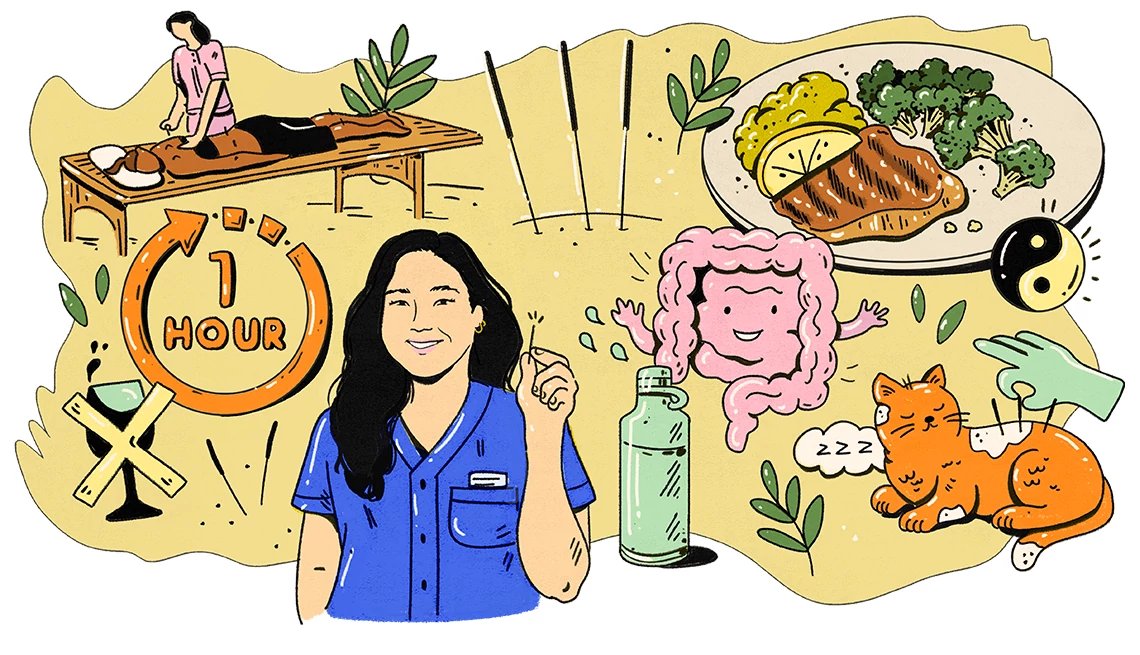AARP Hearing Center


To the uninitiated, acupuncture can seem like a scary prospect. Who’d want to let anyone insert tiny needles into them willingly? Older adults, that’s who. Nearly two-thirds of people over 65 who volunteered for an acupuncture trial conducted by Kaiser Permanente had at least some previous acupuncture experience, according to a 2024 survey, with the majority (84.8 percent) seeking it out as an alternative therapy for pain-related issues.
The healing practice, which has been used for centuries in traditional Chinese medicine, involves inserting very thin needles into the skin at strategic points across the body, leaving them in for 20 to 40 minutes, to treat arthritis, migraines, back pain, insomnia and even respiratory issues.
If you’ve always wanted to try acupuncture but are too nervous to make that first appointment, Eileen Li is here to help. She’s a second-generation licensed acupuncturist, physical therapist and Chinese medicine herbalist who’s worked in the field since 2014 and has run her own acupuncture practice in Greenwich, Connecticut, since 2021. Here, she shares in her words some of the secrets of her trade to put your mind at ease.
1. Acupuncture needles aren’t as painful as you think
Acupuncture needles are nothing like the ones at the doctor’s office. They’re hair-thin, flexible, and most people barely feel them. You may feel a sensation, a pinch or a prick, and they are typically not painful, though everyone experiences sensations differently. Some practitioners use a guide tube to apply light pressure around the area, which makes insertion even more comfortable. Others free-hand the needle. Either way, it goes in fast — before you even finish your exhale, it’s already in. Most people are surprised by how little they actually feel.
2. There’s more than one style of acupuncture
Acupuncture comes in many styles, and they can feel different depending on who you see. Here are some of the most common styles:
- Japanese-style acupuncture uses extremely thin needles with very gentle insertion. It’s subtle and often great for people who are sensitive or needle-averse. Not all practitioners use this method, so if you’re curious about it, it’s a good idea to ask ahead when booking.
- Chinese-style acupuncture (a part of what is often called TCM, or traditional Chinese medicine) is the most common in the U.S. The needling technique may involve more stimulation or manipulation — like that dull, light muscle ache some people feel at the point. This is the most common style that traditional practitioners will use.
- Trigger point or dry needling-style acupuncture focuses more on the muscular system. It’s commonly used by practitioners trained in orthopedics or sports medicine and can feel more intense, like a muscle twitch or release. It’s great for stubborn pain or physical tension, and to help improve range of motion and function.
- Five Element acupuncture is rooted in the emotional side of health. Treatments are often minimal but powerful, and many people report deep emotional shifts, even with fewer needles.
A licensed acupuncturist can be trained in multiple styles and may adjust their approach based on your needs. So if you tried acupuncture once and didn’t love the experience (or didn’t feel results), don’t write it off. Sometimes it takes trying a different style or practitioner to find the right fit. Just like with any health care provider, a little shopping around is completely valid and often necessary.
3. You’re going to be asked some weird questions
Acupuncturists usually want to know about your general health and how you’re living day-to-day — like how you sleep, what you eat, how tired you feel, your mood, stress levels and digestion, including bowel habits. This is because the body doesn’t work in isolated parts. In Chinese medicine, everything is connected: Your digestion tells me about your energy and how well you’ll recover; your sleep reflects your nervous system and stress levels; and your mood often gives us the biggest clue about what’s out of sync.We’re not asking to be nosy — we’re here to understand the whole picture. The goal is to spot patterns so we can treat the root cause, not just chase symptoms. For instance, if you come in for neck pain and we go through what we call the “10 questions” in traditional Chinese medicine, we’re actually getting a better sense of how quickly or slowly your body might heal. If your digestion is off, your body might not be breaking down protein efficiently, which you need to rebuild tissue and generate energy. All of that matters when it comes to healing.
4. An appointment takes less time than going out to lunch
New patients often worry that an acupuncture session will be an all-day commitment. But a typical first session, which includes your initial intake and treatment, generally lasts about an hour, roughly as long as the average office lunch break. Your first visit may take a little longer, if only because of the paperwork and getting your full medical history. The number of needles used for that first appointment can vary, depending on your condition and the practitioner’s style, but typically it’ll be anywhere from four to 40 needles.
5. Hit the gym before (but not after) getting acupuncture
If you’ve got a tough workout planned, do it before your session, and use acupuncture as part of your recovery. Gentle movement like walking or stretching is totally fine, but skip anything intense. After your session, you might feel super relaxed, tired or even euphoric. Give your body a little time to recalibrate.




































































You Might Also Like
Heart Health Secrets from a Cardiologist
Keep your ticker in great shape as you age
Top Colorectal Surgeon Shares Insider Secrets
Don't let embarrassment keep you from getting answers
A top dentist shares tips on the right way to brush your teeth
16 tips on how you can brush up on your oral care strategies